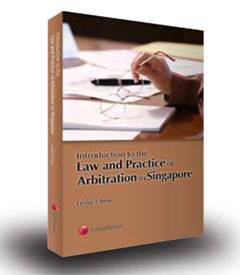|
LIFESTYLE |
 |
Leslie Chew’s Introduction to the Law and Practice of Arbitration in Singapore |
Arbitration is a funny thing. Much of its raison d’etre and success rests on its simplicity, unburdened by technical rules of procedure. On the other hand, it has become increasingly sophisticated in its development and use in high stake disputes led by the best legal minds in business. It is no surprise then that end-users, lawyers and arbitrators taking their first steps find the process to be a rather mysterious and even daunting adventure.
There is great interest in arbitration in Singapore. The flow of foreign expertise into Singapore is matched by rising interest among local practitioners wanting to participate in this promising new area of practice. Many arbitration courses are offered by professional and educational institutions, all respectably subscribed. What students and new practitioners lack is a text to introduce them to the subject.
Although many arbitration books are available in the market, hardly any deal with the Singapore context. Last year, Merkin & Hjalmarsson’s Singapore Arbitration Legislation – Annotated was published and welcomed by arbitration practitioners seeking a handy reference of judicial interpretation of Singapore arbitration statutes. That was not written as an explanatory textbook on the principles and procedures of arbitration. Those new to the subject may well be lost among the meticulous footnotes capturing arguments on complex points.
This is why District Judge Leslie Chew’s book is a long overdue necessity as it employs a gentler approach. For a start, it explains core concepts that underpin modern arbitration. As Mr Chew says:
International arbitration usually involves the interaction of different laws and rules. It is, in practice, a complex interaction of different laws and rules. Many lawyers who do not practise or have not practiced in the field of arbitration for any significant period and have not received specialized training in that regard are often confused over the precise relationship between arbitration rules and arbitration law. Arbitration is unique in many ways and many of its principles and practices run counter to what lawyers are normally accustomed to or, more accurately, trained to deal with.
The book gives an overview of the arbitral process in Singapore from commencement to the enforcement of award. Its tone is conversational and its narrative clear, without being perfunctory. Although modestly titled Introduction to the Law and Practice of Arbitration in Singapore, there are sections of the book that discuss at length, controversies that dogged courts here and abroad. Significant attention is spent on the separability of the arbitration agreement and the competence-competence of Tribunals. Entire chapters are devoted to the role of public policy in arbitration as well as recent developments on interim measures.
Some will find particularly helpful, the chapters on major arbitration rules and the practical aspects of an arbitration. Institutional rules are periodically revised. Both the SIAC (Singapore International Arbitration Centre) and ICC (International Chamber of Commerce) Rules will have new versions soon. Nonetheless, the author’s explanation of the approach of these institutions towards arbitral procedure will remain relevant for some time.
The book does not pretend to be exhaustive on the nuances and exceptions to the general principles expounded. Practitioners arguing the finer points of arbitration law may have to search further for additional resources. This does not diminish the value of the book as either a first point of reference or an explanatory text. When speaking to a general audience, as the author intends to, one says “The Earth is round” rather than “The Earth is an oblate spheroid”. It suffices for many to know that they will not fall off the edge. Armed with this basic and crucial knowledge, it is up to those with specialist endeavours to explore for themselves the difference between the Earth’s equatorial and polar diameters.
Chan Leng Sun*
Ang & Partners
*Mr Chan Leng Sun also chairs the ADR Committee of the Law Society of Singapore.